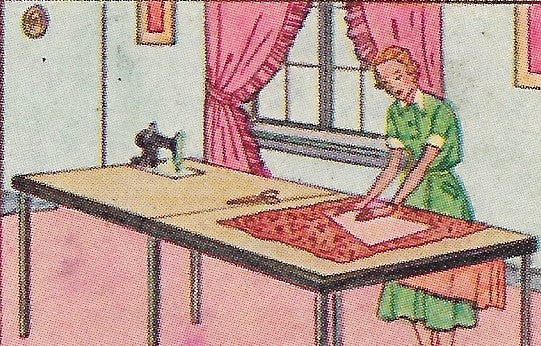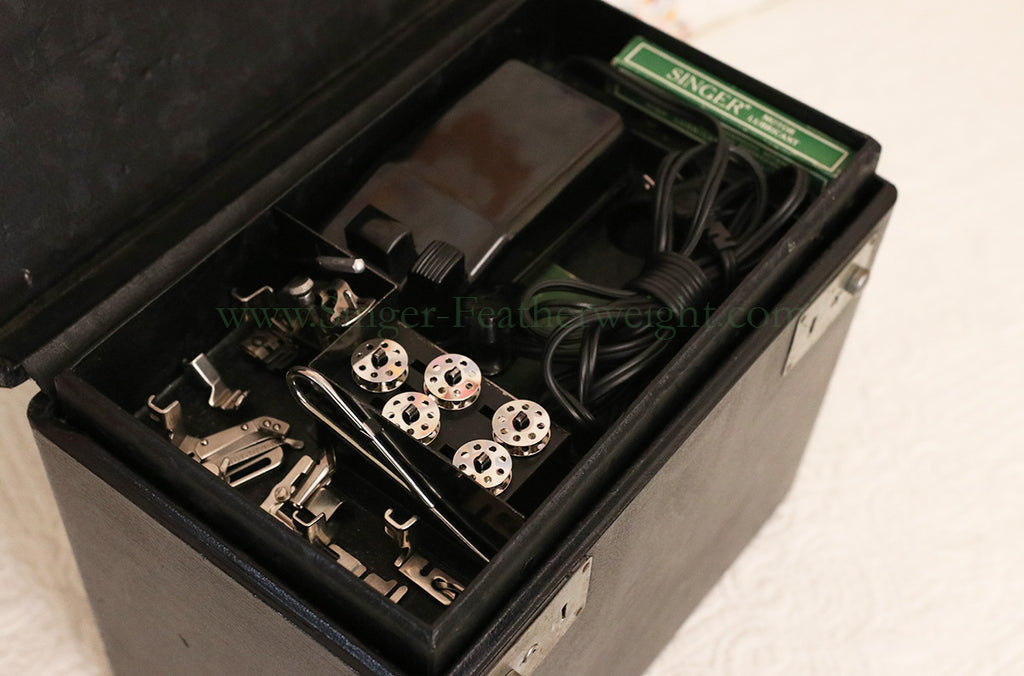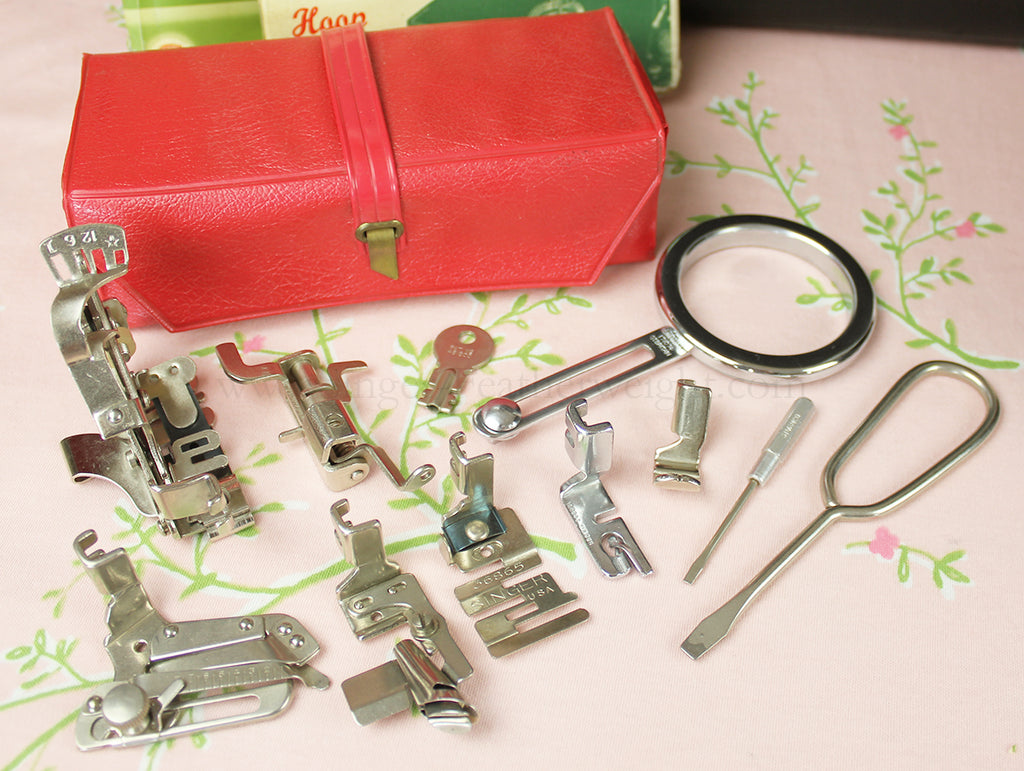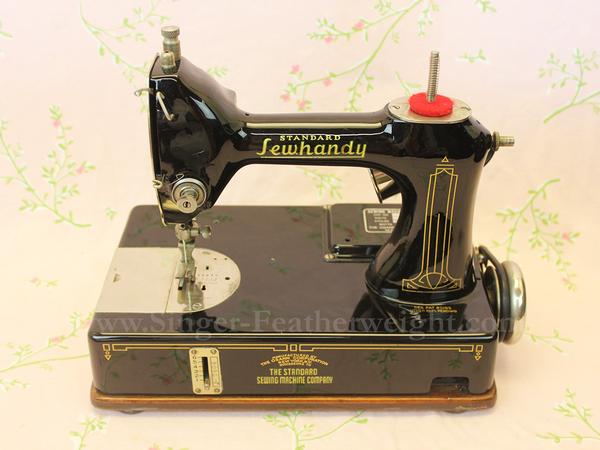Taxes and discounts calculated in checkout.
BROWSE SCHOOLHOUSE
Original Featherweight Tables and Cabinets
Singer tables were what any 1940s homemaker would have wanted to accompany her machine: an adaptable table for sewing or hosting! Below is a cute ad from Singer, marketing the different ways one of their tables could be used... Pinochle anyone? Today, some of the most collectible sewing machine tables and cabinets are the ones for the Featherweight. Below are the various options that can still be found at antique shops, flea markets or even the occasional yard sale -- don't forget to look at what the garage sale goods are "sitting upon", or take a peek under the tablecloth of the...
A Complete Guide to the Variations of Featherweight Hook Assemblies
The hook assembly can be considered the heart of your machine, crucial for timing and stitch formation. Singer did update the design of the hook assembly a few times over the years, and the precision engineering involved means these parts are not interchangeable. This guide is not only a historically interesting look at the inner workings of your machine, but a useful parts identification guide should you need to repair the hook assembly on your Singer Featherweight. The diagram below shows the disassembled parts with the corresponding part numbers as well as the complete unit part #45924. The above photo...
A Concise History of the Featherweight Case
For Singer, the number one selling point for the Featherweight was its portability with the lightweight design of the machine unique and desirable. For the Singer Featherweight to truly be portable, however, it also had to have a lightweight and compact case - one that would hold the machine, controller and all the accessories. The Singer Featherweight case is distinctive, and a component that unquestionably sets the machine apart from others Singer made. In this article, we will analyze the different Featherweight case styles and the various components throughout their years of manufacture. Type I 1933: Some of the most...
Original Featherweight Foot Controller History and Timeline
Singer made a variety of foot controllers over the years, and a few different styles for the Featherweight. All vintage original Featherweight foot controllers are universal and can work with 110 or 220 voltage and with any Featherweight model whether 221 or 222 (the actual plug to the machine may differ, however). In this post you will be able to see the different foot controller variations that were produced for the Featherweight. I. 1933 This was the first controller issued for the Featherweights, and they were issued with approximately the first 200 Featherweight machines ever produced. Not only was it made...
A Featherweight Comparison Guide - Specifics of Each Featherweight 221
Are Some 221 Featherweights Better Than Others? A common question we receive here in the shop is, "Are some Featherweights better than others?" It is a great question and one that we are always verbose to answer! While a Featherweight is a Featherweight is a Featherweight, there were many changes, often subtle, that are interesting to note and can affect the decision-making process when getting ready to buy. This comparison guide will display what distinguishes certain 221 models from others, so it will be easier to determine what Featherweight will be best for you. AD Series 1933-1935: The "AD" series...
How to Pack up the Featherweight and its Accessories in the Case
One question that we get quite often here in the shop is, "how does everything fit in my Featherweight case?" Singer did change the Featherweight cases throughout the years, so packing everything up wasn't always the same. You might be able to get it all in the Case if you pile it in all randomly, but there is a right and wrong way. NOTE: The cases shown in this blog post are for the majority of vintage original Featherweight cases. Stay tuned, though, because we will be updating this post for the early style cases as well - they are...
What accessories originally came with my Featherweight?
The Featherweight is like many other vintage and collectible items; having all the original accessories makes the item more desirable and possibly even more valuable. The question then must be asked, "Do I have all my original accessories?" We know the machine would have originally included a foot controller, case and manual, but what else? Some have screwdrivers, some have five, six, or seven attachments, and some have oil cans. This post should provide you with the information you need to determine whether or not you have all your Featherweight's original accessories.Attachments:We'll start with the attachments that were originally supplied...
Featherweights From Foreign Countries
I am sure there are some of you who have found peculiar things on your machine or among the accessories. While Featherweights were only produced in three countries (USA, UK & Canada), they were sold worldwide. Singer often added decals, logos and extra accessories with machines sold in different countries, and here I will show many of the peculiarities that we have seen here in the shop. CanadaThe Canadian Featherweight History is quite unique and can be a little bit confusing, but hopefully we will be able to shed a little bit of light on the topic. Canada...
A Concise History and Timeline of the Featherweight Bobbin Winder Tension Unit
In the photo below you will see 11 bobbin winder tension units. You can probably see how each one is different, but the question is...are they really all that different? Singer made approximately six standard unique units. Most of the differences that can be seen in the photo are just a different configuration of the same parts. In this post I will walk you through the true differences and peculiarities of each unit. The first unit was of course the unique "School Bell" bobbin winder tension unit. 1933-1935: You can see how the unit on the right has sort of...
A Timeline History of the Singer Featherweight Needle Plate
The Featherweight Needle Throat plate is a valuable piece made with extreme precision. It may seem like just a stationary part, but it must be able to allow the needle to pass through smoothly, the feed dogs to move without rubbing, and the thread to be pulled up through a tight slot. It must be a polished nice looking part, but also a well-crafted tool. Singer had a total of seven throat plates for the Featherweight, and below you can see which throat plates went to which machines. #1-3 1933-1951 The first three plates that are shown all have...
A Timeline History of the Singer Featherweight Faceplate
I'm sure many of you have seen the decorative scrolled Featherweight faceplates, and one very common question we get here in the Featherweight Shop is, "Can I exchange my striated faceplate for the decorative scrolled one?" The answer is: If you're not a purist and originality is not important, you most certainly can! The faceplate on the Featherweight is really the finishing touch. Singer didn't give the option for custom configurations to their customers, but nowadays you can use other vintage Featherweight parts to make yours exactly how you want it. Some of you want that pretty scrolled faceplate on your Featherweight regardless...
Is My Featherweight a Blackside?
Blackside Featherweights were made in 1941 and 1945, but I'm sure you've noticed some other Featherweights that had some blackside parts, too. There were parts like thumb screws and bobbin winders that were made with blackside finish, but do these parts indicate that the machine is a true Blackside Featherweight? In 1941 and 1945 there was a moratorium on chromium as a result of the war, so during this time Singer produced a few Featherweight parts with a black oxide finish. Of these blackened parts, there are specific ones that make for a true Blackside Featherweight. They are distinctive and...
Bobbin Case History of the Singer Featherweight 221 and 222
Many bobbin cases look alike, but here you can learn more of their history with the Singer Featherweight 221 and 222.
Singer Featherweight Texas Centennial - 1936
The Texas Centennial 1836 - 1936 badged Featherweight is probably the rarest of the rare... the most scarce Featherweight to find because of the short time period for which they were available - just over 5 months. Moreover, this particular badge is the only "Texas" Featherweight badge officially recognized and documented by Featherweight historians to date. *Texas Centennial Featherweight photographed above is now owned by a very lovely and highly acclaimed quilter, but most of all, the new owner is a Texan through and through! Celebrating 100 years of Independence from Mexico, Texas commemorated the occasion by hosting the world's...
The Standard Sewhandy, General Electric & Early Featherweight History
Singer "Featherweight" history actually begins before Singer and before 1933 & 1934 (when Singer debuted their model 221 at the Chicago World's Fair). The "Featherweight" name and style really had its beginnings in 1928, when the Standard Sewing Machine Company marketed the first "Featherweight" Sewing Machine. It seems they were still toying with design names, however, as it later became known as the "Sewhandy". The compact sewing machine came in an array of colors - "marine blue, larch green... ashes of roses and black....". Even though Standard eventually sold to the Osann Corporation, the "Sewhandy" name remained iconic when General Electric...
Singer Sewing at the St. John's Factory, Quebec, Canada
Today we are featuring a guest article by Lynne McFern of Ste-Catherine, Quebec, Canada. After acquiring a Singer Featherweight and rekindling a link to her past, Lynne was inspired to learn more about the history of her machines. This is her story... *********************************************** My first sewing experience was on a Singer 66 treadle that had previously been owned by my grandmother. I was very proud of having mastered peddle power until I accidentally sewed through my index finger. That slowed me down a little, but it did not hinder my passion for old sewing machines. Recently, I bought a 221...
Singer Featherweight Centennial 1851-1951
Singer, rightfully proud of its company history, celebrated its centenary in 1951 by giving all machines commissioned for that year a special commemorative badge. It was the standard Singer emblem of the time but with the inscription "A Century of Sewing Service 1851-1951" around the outside of the oval. These "limited edition" models, commissioned for only one year, are sought after by collectors and will add slightly more value to the machine assuming the machine is in comparable condition to a standard Featherweight. Most Centennial badged machines have the 1951 serial numbers but authenticated models with 1948 to 1952 serial...
The Free-Arm Featherweight 222K and How It Differs From the Featherweight 221
The Singer Featherweight 222K Sewing Machine (and the difference between a Singer 221 model) UPDATE: Click here for a side-by-side comparison images and reference page. Approximately 100,000 222K Featherweights were made worldwide and are one of the best sewing machines ever made. Sometimes referred to as the "Free-Arm Featherweight" by those who are not familiar with the model 222K, these Singer Featherweight sewing machines were manufactured identically to the original 221 but with two additional and highly desirable features: Convertible Flat Bed into Tubular Bed or Free-ArmThis very tiny free-arm allows for easier application of sleeves and cuffs or...
Chicago World's Fair
The Singer Featherweight 221 Model Sewing Machine first debuted at the Chicago World’s Fair in 1934. This Exposition was held from May to November 1933 and May to October 1934 with the motto “Science Finds, Industry Applies, Man Conforms”. The official theme was “A Century of Progress” commemorating Chicago’s 100-year anniversary. Technological innovation with advanced aircraft, dream cars and “Homes of Tomorrow” all drew large crowds with exhibits featuring many modern conveniences. (Click photo below for a panoramic aerial view of the Chicago World’s Fair.) By this time, foot-powered treadle machines were being replaced with electric models...
Singer Featherweight San Francisco 1939-1940
Economists know there is a distinctive difference between rare and scarce. One is limited quantities and the other is limited available resources with which to obtain ... so in all honesty, this Singer Featherweight falls into both categories! At the 1939 and 1940 World's Fair held in San Francisco, California, very few Singer Featherweight machines were promotionally badged with the Golden Gate emblem. As you'll see at first glance it looks very, very similar to the Centennial badge frequently seen but has the engraved title "Golden Gate Exposition San Francisco 1939 or 1940". A customer sent this machine...
- « Previous Previous page
- Page 3 of 4
- Next » Next page





















